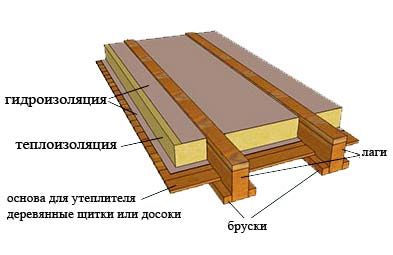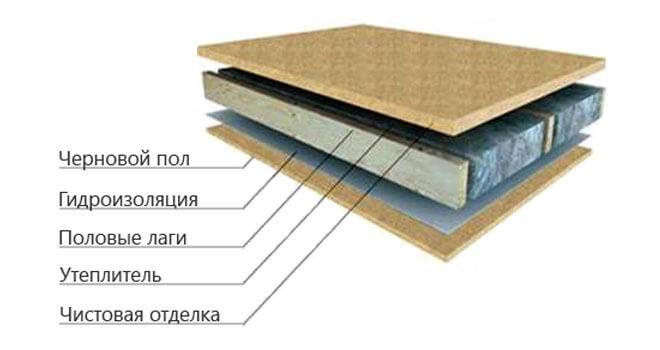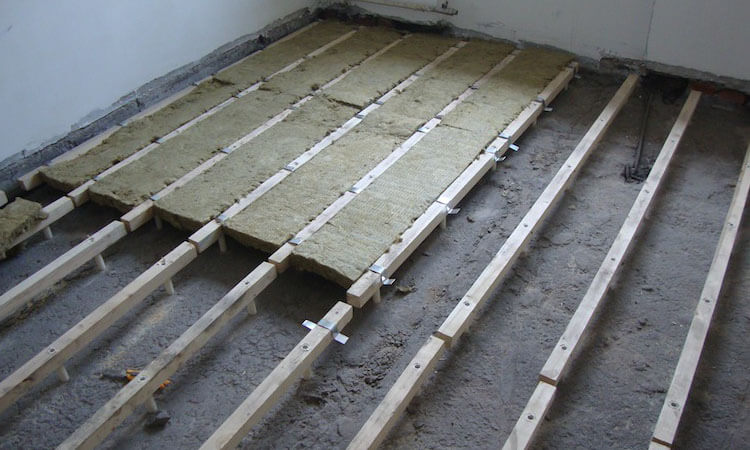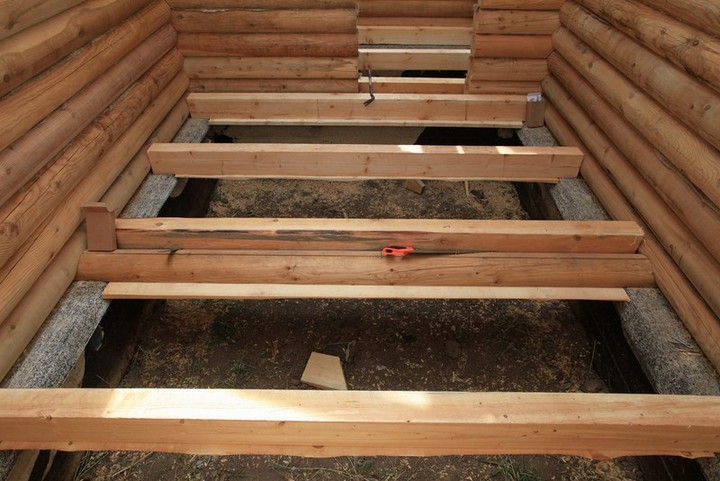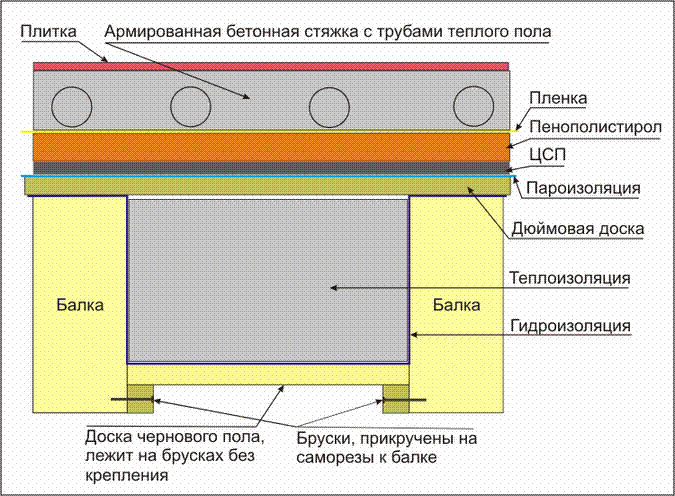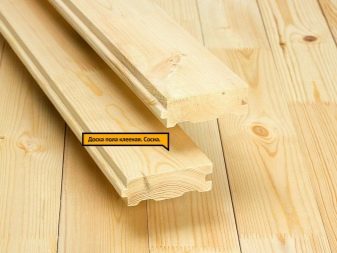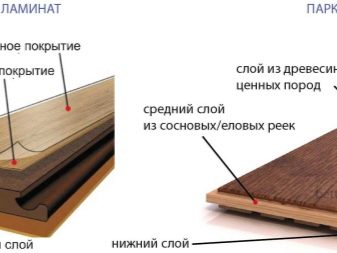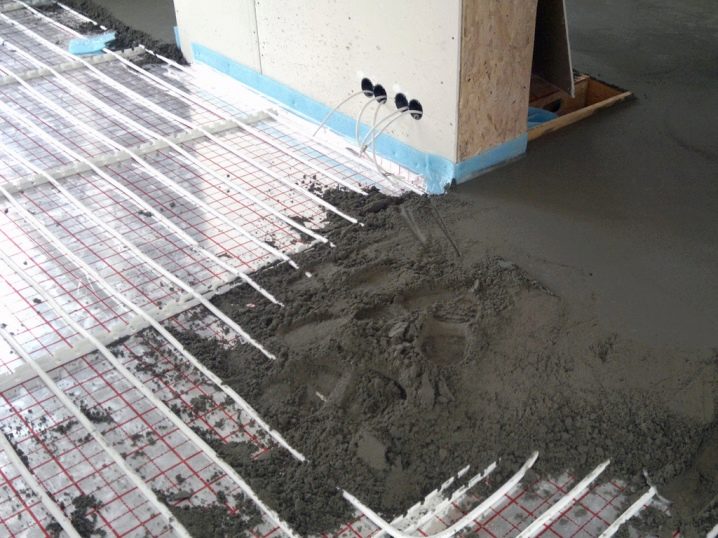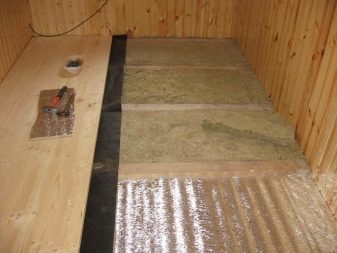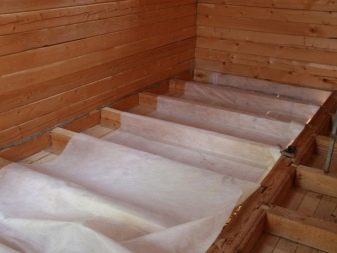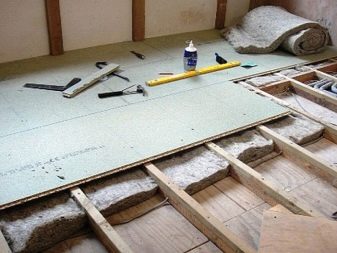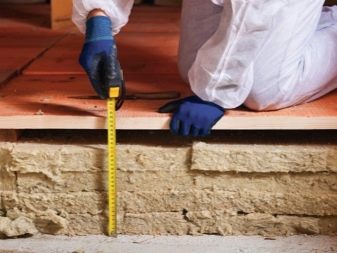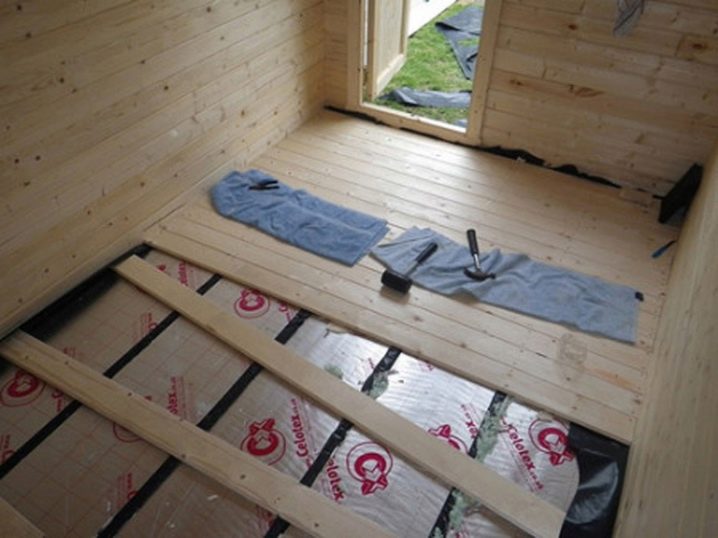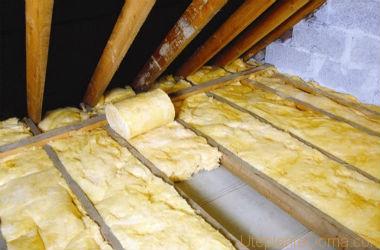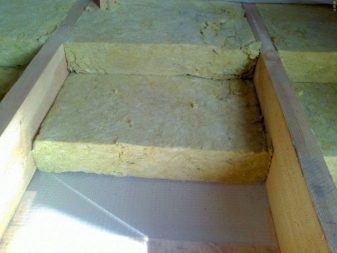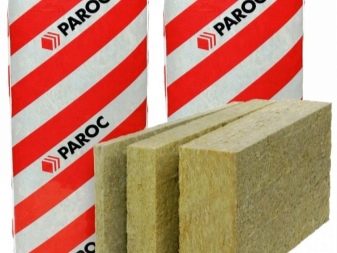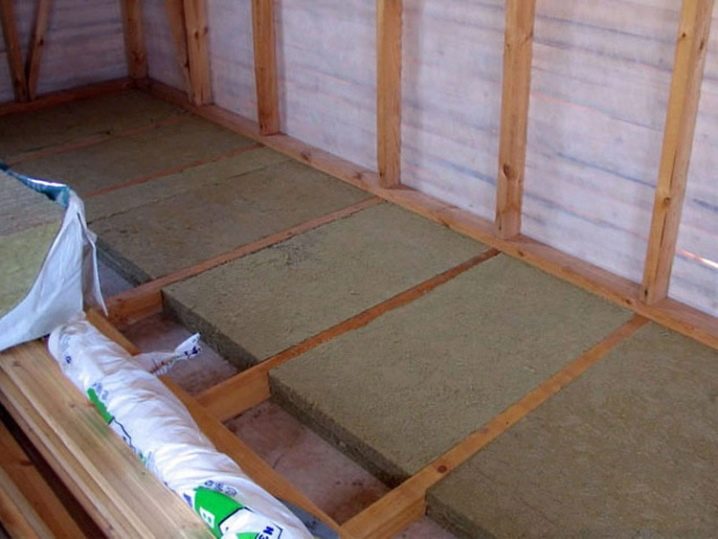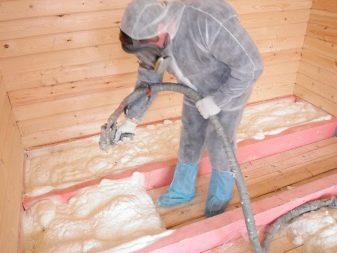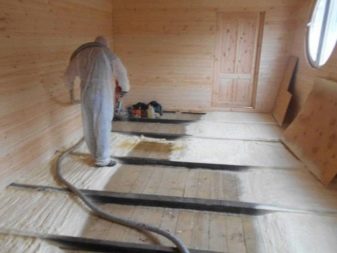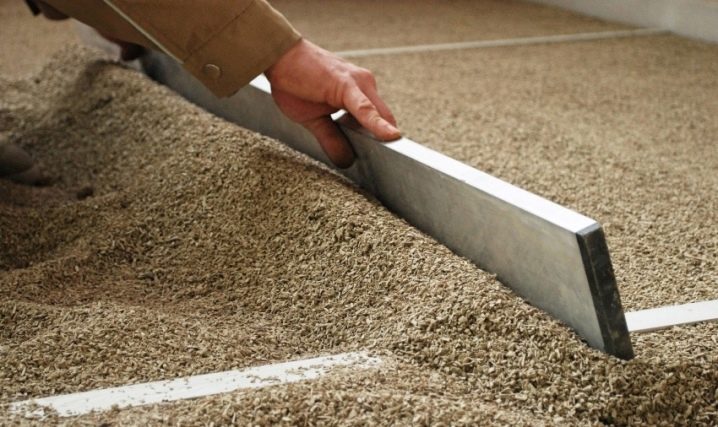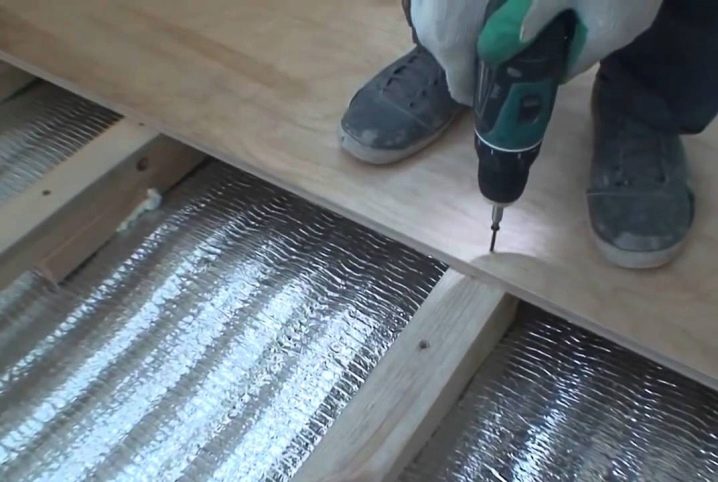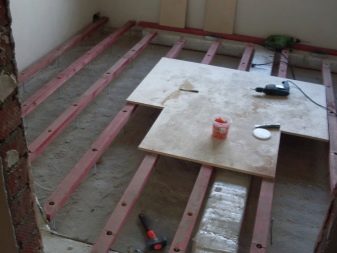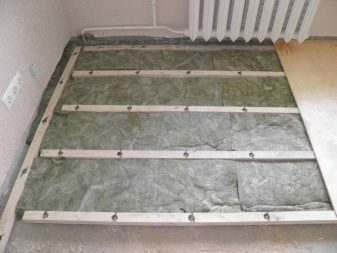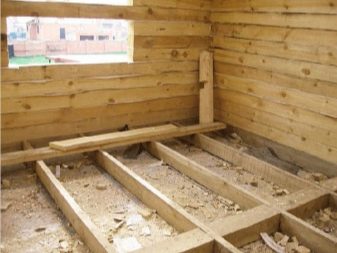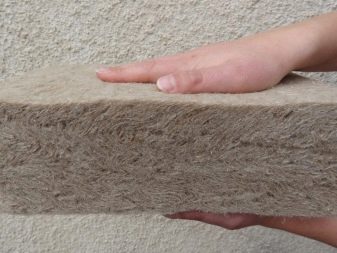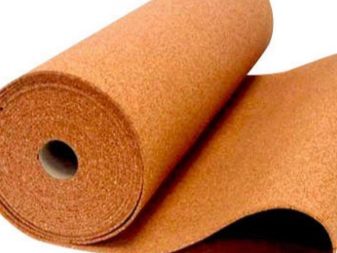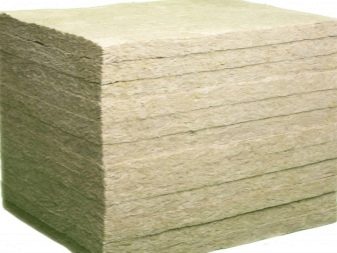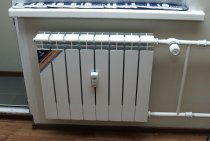Detailed description of technology
First of all, the base (subfloor) is prepared. The floor needs to be repaired, all cracks repaired, leveled. Treat the wooden floor with an antiseptic. Cracks in the concrete floor can be repaired with a cement mortar or mounting foam with further removal of excess. Coat the soil floor with clay. At the final stage - dry and clean from debris.
After preparation, waterproofing is performed - a polyethylene film or membrane is laid on the base. If one sheet is not enough, and in most cases it is, the film is overlapped, that is, so that one edge of the film lies on the other, at a distance of 10-15 cm. The sheets are fastened together with adhesive tape or double-sided tape. This process requires maximum care when working on concrete floors, since it is easiest to tear the film or membrane on them.
Installing lags is the most important stage of work. The logs are made of wooden beams and are installed between the walls in increments equal to the width of the insulation sheets. Most often, the width of the sheets is 1 meter. This means that the logs should also be installed in increments of 1 m. Sometimes it is recommended to do a little less so that the gaps are minimal. For fastening the lags, dowel-nails with screws are used.
It is imperative that all lags are strictly horizontal. This is the main condition for them to be able to install a flat floor.
For their alignment, a long liquid or laser level is used.
Work begins with the installation of side lags running along the walls. Drive in short ones between long bars so that cells are obtained, slightly smaller in size than the dimensions of the insulation sheets. If wool in rolls is used as insulation, there is no need to make jumpers between the lags.
At the end of the work, the entire system is carefully treated with an antiseptic. The level is checked again with a level.
Insulation sheets are laid. If the cells were made slightly smaller than a sheet of mineral wool, then it is enough to squeeze the wool slightly. When it falls into place, it will straighten up and fill all the cracks. Styrofoam is better to cut at the place of laying. This will help to avoid even the smallest cracks.
A hydrobarrier is also installed on top of the insulation. It can be either a polyethylene film or specialized materials with or without a metallized layer. This is necessary to protect the insulation in cases where something is spilled on the floor.
As with the bottom film, the sheets are overlapped so that the edges overlap each other by 10-15 cm. The joints are sealed with double-sided tape or adhesive tape.
A lining for a finishing floor made of plywood is mounted on top. Plywood sheets are fastened with self-tapping screws or kleimers. As a rule, the distance between the walls is measured first. Plywood sheets are marked so that the plywood coating is about 1 cm away from the walls. The fact is that the plywood lining can expand as it is installed and it is better to compensate for this expansion in advance. And the remaining gap will then be closed with skirting boards.
When laying plywood, you need to ensure that the joints are located in the center of the lag-bars. To achieve this, the sheets are cut with an electric jigsaw or circular saw.
In addition, we must not forget that as you move through the room, its width can change up or down. Accordingly, the width of the plywood sheets should be adjusted.
The biggest difficulty will be the installation of the last sheets of plywood. They will have to be cut not only along, but also across. The entire resulting structure is once again treated with an antiseptic solution.
A finished floor can be installed on the resulting plywood lining.
In some cases, in order to eliminate possible gaps, a two-layer floor insulation is made. In this case, the second layer is located across the first. That is, another lag structure is attached on top of the first layer and another layer of insulation with appropriate waterproofing is laid.
Features of floor insulation
floor insulation diagram.
It is mandatory to use mineral wool together with other materials, among them there must be different membranes, vapor barrier films, etc. When choosing mineral wool, it should be remembered that the material that is made on the basis of fiberglass is capable of demonstrating increased fragility. In order to eliminate this drawback, some manufacturers add a number of chemical additives, such as formaldehyde. But it has a bad effect on the human body. It is for this reason that mineral wool, made on the basis of basalt fiber, should be preferred - this material is completely safe.
Before the process of warming the floor of a wooden house, you should decide which type of material to prefer. Insulation can be represented by rigid mats, flexible plates and rolls. According to the standard, the classification is much broader, however, one of the above types of mineral wool can be used for high-quality and effective insulation.
The technological process of thermal insulation is divided into 5 separate stages. The first stage involves the installation of the lower floor sheathing. To do this, you can choose solid plank flooring, which is true for a house that lacks a basement; you can also choose sand preparation, which is applicable in the case of a floor on the ground and the presence of a basement. The second stage of work involves waterproofing. This will prevent the penetration of water during the period of snow melting or the spring rise of groundwater. The next step will be mineral wool flooring. In this case, the plates should be laid as close as possible to each other so as to avoid the formation of gaps. When rolling out the roll, the formation of unwanted gaps should be excluded. Next, the floors in a wooden house should be covered with a layer of vapor barrier, after which you can proceed to the installation of the final floor. This should be done using special bars designed to provide an air gap between the insulation and the floor boards.
The sequence of floor insulation
Warming the floor of a wooden or stone house can be conditionally divided into several stages:
- 1. Preliminary preparatory work.
- 2. Laying waterproofing.
- 3. Installation of insulating materials.
- 4. Floor vapor barrier.
- 5. Roughing, finishing and surface reinforcement.
Thermal insulation works are carried out using mineral wool, according to the developed schemes, each of which may differ.
Ground surface with brick columns
Fasteners are used to fix the floor log. Wooden blocks are placed along the entire length of the log, through which the flooring is laid. Up to the top of the columns, the internal space is filled with expanded clay. Mineral or stone wool, waterproofing components are laid on top of the log. A vapor barrier is placed on top, and all joints are glued with construction tape.
Soil with compaction
It is a traditional floor construction for modern country houses. The working coating is laid on supporting logs installed on compacted soil or gravel. Stone or mineral wool is placed after filling the space with expanded clay and placing waterproofing. It is advisable to install the mats as tightly as possible, without gaps. A vapor barrier is usually placed on top, after which there is a reinforced screed or subfloor.
concrete base
Initially, a vapor barrier is placed so that the foil side is facing the stove.Then comes mineral wool, which can be laid with or without a crate. As in the previous schemes, it is recommended to avoid gaps and irregularities. The final layer should be a vapor barrier.
Instructions for warming the attic floor with mineral wool
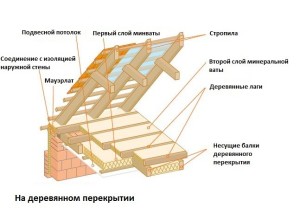
Insulation of the attic floor with mineral wool consists of several stages:
- Spread glassine on the attic floor. If financial resources allow, it is better to buy a special vapor barrier film, because ideally a vapor barrier is also needed.
- The film is overlapped, and the joints should be walked with adhesive tape or fixed with wooden slats, fixed with a special tool - a construction stapler.
- Armed with mineral wool, it is necessary to determine the volume of the substance used, having previously studied the heat standards for your region.
- When working with mineral wool, lay it tightly so that there are no joints and empty spaces. Additionally, the seams are glued with adhesive tape.
- The top layer, located on top of the lags, is boards, which, in principle, form the attic floor. Such a maneuver will allow the insulation to “breathe” and avoid the appearance of mold if liquid suddenly gets on the mineral wool.
Do not forget that when working with mineral wool, it is necessary to use protective equipment, it can be thick clothes with long sleeves, goggles, tight gloves and a respirator that protects against foreign substances entering the respiratory tract.
Mineral wool attic insulation is shown in the video: https://www.youtube.com/watch?v=MbQ686qYvco
Mineral wool differences
As we have said, there are three types of mineral wool insulation. Each of them is made from different raw materials and has its own properties.
Advantages:
- Breathability.
- Fire resistance.
- Elasticity, resistance to vibrations.
- Withstands low temperatures.
- Lower cost than other mineral wool.
Minuses:
- Short shelf life - 5-10 years.
- Shrinkage 80%.
- Strongly absorbs moisture.
- If it comes into contact with the skin, it causes itching or even an allergic reaction.
As for the scope, usually it is mineral wool for wall insulation inside the house.
slag wool
Produced from metallurgical waste. Inferior in characteristics to other types of heaters.
- Does not provide adequate sound insulation.
- Cannot withstand high heat. It does not burn, but it sinters and loses its heat-insulating qualities.
- Does not tolerate temperature changes.
- Protective clothing and a respirator for installation are also required.
- It is impossible to insulate damp rooms with metal fasteners, since under the influence of moist air, slags will contribute to corrosion.
- High hygroscopicity.
Plus - such a layer in the wall does not attract rodents and insects. Most often used on dry surfaces of temporary structures or non-residential buildings.
Stone
The most expensive material It is he who is usually chosen for outdoor work in private, including frame wooden houses. Rocks are used in production. Thanks to this, the final product has a lot of advantages:
- High density, and hence strength.
- Fire resistance. Does not ignite at any temperature.
- Minimum shrinkage (5%).
- Long service life (up to 50 years).
- Provides excellent sound insulation.
- Almost does not break during operation, which happens with other types of products.
- Vapor permeability. The fibers repel moisture.
Minus - high cost. Despite all the advantages, it is not always rational to insulate with these plates.
The nuances of floor insulation with mineral wool
When arranging the floor in a private house, fiber insulation is used in the following cases:
- for insulation of the base above the basement.The basement space is most often not heated, and under the influence of cold air from below, the floor slabs do a poor job of saving heat in the room. According to experts, the cold intensively enters the house through an uninsulated base, which leads to the leakage of a large part of the thermal energy from the room;
- for heat and sound insulation of interfloor ceilings. Mineral wool in a multilayer structure of floors between floors is positioned as the best option for thermal insulation. The use of insulation with a fibrous structure allows you to maintain an independent microclimate in rooms that are located at different levels of the building. The high sound absorption properties of this material contribute to the creation of a reliable barrier against the spread of sound effects, which often occur during the operation of household appliances or utilities;
- for the arrangement of the attic floor. The under-roof space is constantly exposed to the aggressive effects of climatic conditions. Seasonal frosts or heat, dampness and wind loads negatively affect the state of the attic floor. To protect the structure from external influences, it is recommended to equip a complex barrier made of mineral wool and means of hydro- and vapor barrier.
Mineral wool is available in rolls, slabs and flexible mats with various specifications. Rolled products provide for low rigidity, the width of the products is 0.6 and 1.2 m, the length is up to 10 m. The material is relevant for the arrangement of large areas, as it allows minimizing the number of joints in the heat-insulating layer. For the installation of rolls, a crate is made, the insulation is laid in two layers.
 Mineral wool in slabs
Mineral wool in slabs
Mineral fiber slabs with a dense structure are mainly used for arranging a soil base. The material is laid without framing and poured with mortar. Mineral wool in slabs contains hydrophobic components. One side of the product has more rigidity than the other. The manufacturer's instructions specify the installation requirements, taking into account the characteristics of the product. The factory packaging of tile insulation is designed for arranging an area of 1-4 m² in one layer. Dimensions: 50x100 cm.
The front surface of a flexible mat with a hydrophobized composition is laminated using perforated kraft paper. When installing the insulator, the treated side must lie in the direction of the space to be insulated.
When planning the thermal insulation of the floor with mineral wool in a private house, the following nuances should be considered:
- the thickness of the mineral wool for warming a wooden or concrete floor is selected depending on the operating conditions, including the purpose of the area to be equipped and the climatic features of the area;
- the base of houses in the southern regions is recommended to be insulated with models of a mineral insulator 50 mm thick. A material with similar characteristics is also suitable for arranging the floor in a country house, which is used exclusively during the warm season;
- on interfloor ceilings, an insulating resource made of mineral fibers 50 mm thick is used due to the low requirements for environmental temperature parameters in a given space;
- for high-quality thermal insulation of the floor in a country house, mineral insulation with a layer thickness of up to 200 mm is required.
How to choose mineral wool products
First you need to pay attention to several characteristics:
- Mineral wool thickness for wall insulation. The thicker the insulation layer, the higher its fire safety, sound insulation and strength. For intra-house partitions and frame structures, 5 cm mats are suitable. For facades - from 5 to 10 cm.
- Density (P). We wrote about it above. The rigidity of the structure and its ability to withstand loads depend on it. For facades, the indicator should be in the range of 100-125 kg / m³.If plaster is chosen as the finish, then 150 kg / m³. For interior partitions - 75-90 kg / m³.
- Thermal conductivity. The smaller it is, the better. In this regard, basalt and fiberglass products have proven themselves well.
- Vapor permeability. A coefficient suitable for private buildings is for stone wool. Designated MU1. The larger it is, the better the product.
- Fire resistance. The level of fire resistance of fiberglass is 600⁰ C, material from mountain alloys is 1000º C.
What else to pay attention to
If you plan to work outside the building, choose basalt slabs. When insulation is required from the inside, a fiberglass coating is also suitable. When buying, look at the storage conditions.
- If the product is even a little wet, it makes no sense to purchase it. Check that there are no holes in the packaging.
- Blocks and rolls should be under a canopy, not outdoors.
The most famous manufacturers of mineral insulation are Isover, URSA, Rockwool, Knauf. Their products are certified and quality tested.
Styrofoam
Usually this word refers to foamed polystyrene and extruded polystyrene (foam). In terms of chemical composition and thermal insulation properties, these materials practically do not differ, however, foam plastic has much greater bending strength and resistance to crumbling than traditional foam plastic. For this reason, most consumers have recently abandoned expanded polystyrene (polystyrene) in favor of extruded polystyrene (polystyrene foam).
The advantage of this type of thermal insulation is low price, ease of installation and moisture resistance. The disadvantages include the combustibility of this material, and when burning polystyrene, a large amount of toxic substances are released.
Polystyrene boards are produced with a thickness from 5 mm to 50 mm, a special chamfer is made on the edges of the boards so that no gaps appear during installation at the joints, and therefore “cold paths”.
If a layer thickness of more than 50 mm is required, then two or even three layers of polystyrene are laid, while each new layer is laid with an offset relative to the previous one, so that the joints of the top row slabs fall on the centers of the bottom slabs.
Styrofoam screed scheme
When insulating a floor located directly above the ground, the foam layer must be at least 300 mm for a house with a wooden floor, and 200 mm for a house with self-leveling concrete floors. You should lay at least 4 layers of the thickest Styrofoam panels offset from each other.
If there is a cold basement under the floor, then the foam layer can be reduced by 50mm.
To insulate the floors between the floors of a private house, 150 mm of foam plastic is enough for wooden floors and 100 mm for concrete floors.
If you are insulating floors in an apartment building, then for all floors, except for the first one, it is enough to lay one layer of foam plastic 50 mm thick. On the ground floor, the thickness can be increased to 80-100 mm.
| Indicator | Polyspen | Polispen Standard | Polyspen 45 | Control method |
|---|---|---|---|---|
| Density, kg/m3 | 30-38 | 30-38 | 38,1-45 | by 5.6 |
| Bending strength, MPa, not less than | 0,4 | 0,4 | 0,4 | by 5.8 |
| Water absorption in 24 hours, % by volume, no more | 0,4 | 0,4 | 0,4 | by 5.9 |
| Thermal conductivity at 25+-5 degrees Celsius, W/m * °C, no more | 0,028 | 0,028 | 0,030 | by 5.10 |
| Toxicity, Hcl 50, g/m3 | T2 moderately hazardous | T2 moderately hazardous | T2 moderately hazardous | by 5.11 |
| Flammability group | G-3 normal combustible | G-4 highly flammable | G-4 highly flammable | by 5.12 |
| Flammability group | B-2 moderately flammable | B-3 flammable | B-3 flammable | by 5.13 |
| Smoke generation coefficient | High smoke generating capacity | High smoke generating capacity | High smoke generating capacity | by 5.14 |
| Compressive strength at 10% linear deformation, MPa, not less than | 0,2 | 0,2 | 0,3 | by 5.7 |
Estimated thickness of thermal insulation Penoplex
Thermal insulation of the floor in the house
Warming the floor in a wooden house is an extremely important and difficult task.
It should be remembered that for uninsulated floors, heat loss can reach up to 20 percent of the total heat loss.
It will be important not only to correctly insulate the floor area, but also to choose the right insulation itself.
Today, mineral wool is increasingly used for insulation work. This material is a classic in its niche. Everything is due to the advantages of mineral wool as a heat insulator. In a wooden house, this material is usually used, primarily because it is non-combustible, in addition, it will prevent the spread of fire, so its use as a heater allows for additional fire protection of the entire building structure. According to manufacturers, mineral wool fibers are able to withstand temperatures exceeding 1000 degrees.
Scheme of wooden floor insulation.
Mineral wool insulation has gained such high popularity for the reason that this material has excellent thermal insulation characteristics.
It is only important to comply with the insulation technology
Professional builders and home craftsmen also prefer this material for its excellent soundproofing characteristics, which is important, especially when comparing this insulation with some others. Thermal insulation of a house with the help of mineral wool is especially relevant for those buildings that are built in the northern regions, since the insulation has high frost resistance, and with sudden and significant changes in temperature, the insulation is able to demonstrate a complete absence of deformation
This insulation copes well with the effects of chemical and biological reagents. In addition, it is economical and its price is affordable.
Thermal insulation of a house with the help of mineral wool is especially relevant for those buildings that are built in the northern regions, since the insulation has high frost resistance, and with sudden and significant changes in temperature, the insulation is able to demonstrate a complete absence of deformations. This insulation copes well with the effects of chemical and biological reagents. In addition, it is economical and its price is affordable.
Mineral wool, however, is not ideal, it has some disadvantages, among them high porosity, which gives the material low strength. Warming the floor of a wooden house with its use must be accompanied by waterproofing, since without this procedure the material will become wet, blown, losing its characteristics. If the insulation is not carried out correctly, the material will begin to form cold bridges, the pores will begin to accumulate condensate. That is why the insulation must be carefully protected.
Floor types
In houses made of wood, two types of floors are used: concrete and wood.
The second option falls into two categories:
- floor board, glued wood;
- parquet board and laminate.
The concrete floor can be made by hand without the involvement of specialists. There are two options for laying concrete: on the ground and on logs. The most common is the first option.
All work is carried out in several stages:
The next step is to fill the floor with concrete screed. If a warm floor is installed, then it must be installed at this stage.
The wooden floor, like the concrete coating, also has several layers:
- bulk floor (rough);
- waterproofing layer;
- thermal insulation layer;
- clean coverage.
Insulation of a cold attic with mineral wool
A vapor barrier is placed under the mineral wool.
To insulate the ceiling of a cold attic with mineral wool, you can take material of any density, from low to high. In this case, it is still preferable to dwell on lighter materials so as not to create additional loads on the beams.Some experts are inclined to believe that glass wool is better suited for attic insulation with mineral wool than stone wool. The latter is too brittle, and it has considerable weight. They also read: “Which insulation to choose for walls and ceilings“.
As you already understood, the insulation of the cold attic of a private house with mineral wool is carried out by laying thermal insulation between the supporting beams directly on the draft ceiling of the first floor. Due to the high hygroscopicity of mineral wool, a vapor barrier film must be used. In principle, even plain polyethylene can be used. There will be no special loads on the film and with careful installation it will not tear. To be completely sure of the reliability of the protective layer, you need to use a polypropylene vapor barrier reinforced with fiberglass mesh.
Attic insulation with mineral wool, technology:
- load-bearing beams are sewn up from below - this is the draft ceiling of the first floor;
- from the side of the attic, a vapor barrier is laid on the rough coating;
- mineral wool is placed on top of the film.
The vapor barrier tapes must overlap, the joints are glued with double-sided tape. Mineral wool is placed at random so that there are no cold bridges at the junction of the insulation to the beams.
Insulation of a cold attic with mineral wool is always preceded by a calculation of the thickness of the thermal insulation. In any case, the layer will be at least 10 cm. Mineral wool is produced with a thickness of 5 cm or more. It is better to lay the thermal insulation in two layers with offset joints. This will eliminate the possibility of heat loss through the joints of the mineral wool sheets.
After insulating the attic floor with mineral wool, you can immediately lay the floor on top of the beams. It is advisable to close the insulation with waterproofing before this - a material that does not allow water to pass through, while passing steam, but only in one direction
It is important not to confuse which side to lay the waterproofing, otherwise moisture will accumulate in the mineral wool, as a result of which the thermal conductivity of the material will increase significantly
It is quite possible to use a fireplace for heating a country house. To do this, a heat exchanger is built in above the furnace.
Read about how to choose the size of brackets for radiators here.
What can be insulated
Floor insulation in a wooden house is carried out in order to reduce heat loss. The most commonly used and inexpensive heaters are expanded clay and sand. Below is a list of other popular floor insulators.
Mineral wool. The main features of this heat insulator are low thermal conductivity, durability, high noise insulation properties, and moisture absorption. It is also worth noting that mineral wool is an environmentally friendly material.
This insulation is produced in plates and rolls. Roll insulation is most common when used over large areas. Mineral wool is very convenient, no special knowledge and skills are required during operation. Everything can be done by hand. The material is lightweight and breathable.
Polyurethane foam. The heater is quite expensive. This will require not only the help of specialists, but also special equipment. The material is close to polystyrene in its properties. But he will not withstand the screed. They can insulate the floor from below. The average service life of such a heater is 30 years.
Expanded clay. The material is quite common. Expanded clay is granules of fired foamed clay. The material has high performance properties, lightweight. But with all the variety of advantages, there is one serious drawback. Expanded clay absorbs moisture very well, so when using it, it is imperative to install waterproofing.
Sawdust is a bulk insulation option. Against mice, sawdust mixed with slaked lime powder is used: 8 parts of sawdust to 2 parts of lime. Such a heater can be poured between the rough and finishing floors.The average layer thickness is 20-40 cm, depending on climatic conditions.
Isolon is a polyethylene that has a foamed structure. The thickness of this coating is 10 mm. Foiled on one or both sides. It is laid on top of the cotton wool. Also used as underfloor heating.
Ecowool as a type of attic insulation
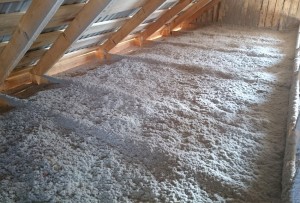
Attic insulation with ecowool looks like this:
- Spread a film on the ceiling and arm yourself with blowing equipment.
- Your task is to lay the cotton wool in an even layer, without gaps and cracks.
- Adhere to a layer thickness of at least 250-300 mm.
- Given the rapid shrinkage, take a layer with an excess of up to 50 mm.
- The insulation of the attic can be considered complete at this point, the stage of moistening the surface remains. For this, a mixture consisting of PVA glue and 1 bucket of clean water is suitable. If there is no glue, you can use only water.
- Humidification occurs by wetting the broom in water and spraying water over the plane.
- When the material dries, you will see how its surface has taken on a crust, builders call it lignin. It provides ecowool with a primary appearance and prevents displacement and deformation.
Peculiarities
Wooden floors, unlike concrete, are much warmer. Wood is a capricious material and when building a house it is not always possible to achieve the desired effect. The ratio of thickness and thermal conductivity is often disproportionate, so floor insulation in a house made of wood is simply necessary.
The possibility of floor insulation is not only in new houses, but also in long-built ones.
Floor insulation helps to maintain an ideal microclimate in the room and serves as a guarantee against such undesirable problems:
- dampness;
- the appearance and reproduction of mold;
- the appearance of microorganisms and fungi that adversely affect the health of those living in the house;
- high consumption of thermal energy for heating the house;
- building damage and destruction.
Insulation of structures involves different types of work:
- insulation of floors above the basement;
- insulation of interfloor ceilings;
- insulation of the ceiling between the living room and the attic.
In each case, materials are used not only to maintain optimal temperature conditions, but also for sound insulation. A well-insulated first floor is a guarantee that the house will become comfortable for living.
Do-it-yourself floor insulation with mineral wool
The technology for insulating a concrete or wooden floor is quite simple, so anyone can insulate a small room on their own.
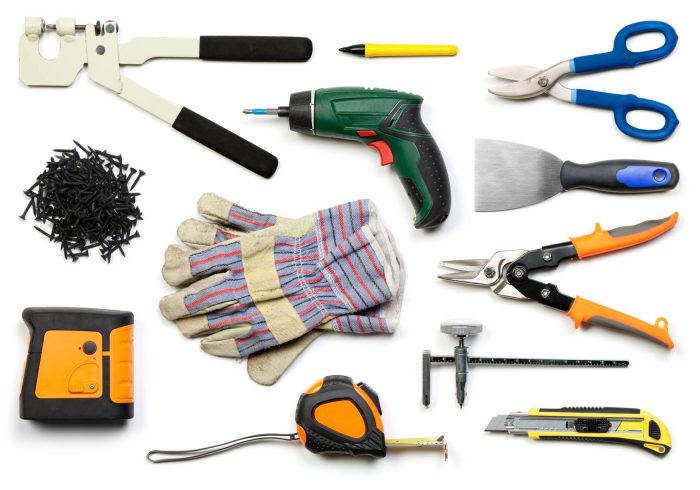
To carry it out, you will need the following tools:
- tape measure for accurate measurement;
- gloves (preferably rubber, because the mineral wool hairs tend to cling to clothes and the body;
- construction stapler for fixing;
- a large clerical knife (this heat-insulating coating is quite thick);
- face protection: goggles and a respirator (as mentioned above, the mineral coating consists of hairs that crumble and cling to clothes during installation so that they do not get into the eyes and respiratory tract, it is necessary to protect these parts of the body);
- 6. screwdriver for installing guides and the outermost layer of the coating;
- 7. screws of various lengths;
Properties of materials for attic insulation
Before buying a heater, experts advise to adhere to the basic requirements:
- Special climatic conditions require the product to be resistant to temperature fluctuations - from -30 to +30 degrees.Ask the seller if the selected product emits harmful substances at hot temperatures, because the household will have to breathe these vapors.
- If there is electrical wiring in the attic, give preference to a fire-resistant insulating material with low flammability.
- We do not even doubt that the roof of your dacha is done well, but it won’t hurt to play it safe - the insulation should not get wet and damp. Negligent attitude to this item can lead to the spread of dampness along the walls of the whole house, it can be very difficult to get rid of the fungus.
- Lightly compacted material quickly "caking" and loses its useful characteristics, so avoid such material.
It is also not superfluous for the owner of the house to focus on the material from which the attic floor is built:
- A wooden beam floor allows the use of heaters made in the form of plates, rolls, including bulk specimens.
- If the floor is concrete poured, heavy bulk or dense, thick heat-insulating materials will do.
